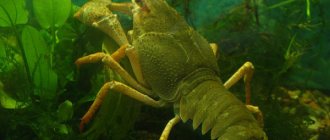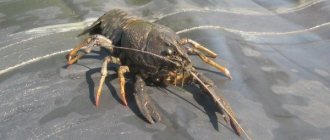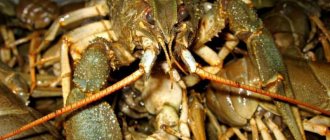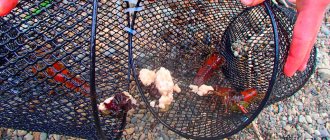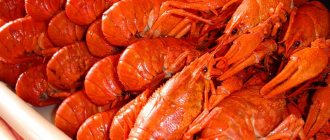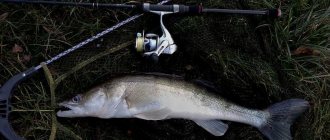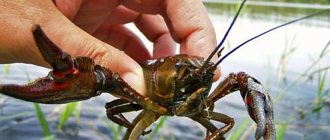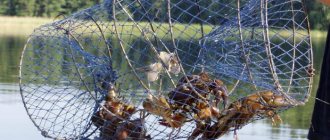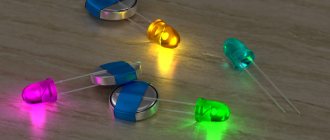December 20, 2013 Victor Home page » Fishing methods Views:
Welcome to my blog! Let's look at how to catch crayfish in this article. There are many ways to catch crayfish, let's look at a few of them. So let's get started. The most popular way to catch crayfish is with meshes. They are gradually replacing other methods. However, there are many methods for catching crayfish that are no less tempting for crayfish hunting enthusiasts.
Manual way to catch crayfish
Catching crayfish with your hands is the simplest and oldest method of hunting. You need to move carefully in the water, without raising turbidity and waves. Inspect all underwater shelters - stones, mud, drowned trees. As soon as you see a crayfish, you should immediately try to grab it with a quick movement, since the crayfish, having noticed the danger, quickly retreats. This method of hunting crayfish is not suitable if you are afraid of being bitten by claws. In these cases, I use car repair gloves. They bite, but it doesn’t hurt, and you pull the crayfish out by the claws.
The best hunting is successful at night; at this time, crayfish come out of their shelters to feed and can be taken with your hands by illuminating the bottom with a flashlight. Previously, fires were lit to attract crayfish. This will help you catch more of them. You can catch crayfish with your hands at shallow depths, no more than 2 meters, but with fins and a mask you can go a little deeper. If you catch crayfish in deeper places, you need to use special pliers, but for this you need the water to be clear.
Pincers are made of wood, preferably hollow, from one to three meters long; they are good for lifting crayfish from the water. For safety reasons, you need two people to catch crayfish so that you can be watched on the shore. There is another device - they take a long stick and make a split at one end, which is expanded with the help of a small stone or stick. With the help of this device, the crayfish is not pulled out, but only pressed to the bottom and then freely taken by hand. This method requires training; crayfish are very suspicious and often hide in shelters. But these methods are only good in clear water, when the crayfish can be clearly seen.
Simple catching of crayfish at night with a fire and a lantern while fishing
Catching crayfish at night involves some difficulties and inconveniences, but once you overcome them, you will be rewarded with an excellent catch.
Probably few people know, but crayfish are quite active at night and it is at this time that the catch can be quite decent. Some crayfishers prefer to catch crayfish in the morning (in addition to fishing), but most (and quite rightly so) start fishing in the evening and continue all night.
It is at this time that crayfish are most active and emerge from their burrows to search for food. Catching crayfish late at night can be successful, but only if done with specially prepared gear.
Fishing methods such as snorkeling and others in the dark are simply absurd. It is also difficult to catch them with a fishing rod, even if it is made specifically for catching crayfish.
Fire fishing
At night, many crayfish fishermen often take advantage of the crayfish’s natural “craving” for light, namely the light from the fire. Fishing with this method is very simple and consists in the fact that the crayfish crawling out into the bright light of the fire need only be collected and placed in a fish tank or basket.
However, in this case it is necessary to act as carefully as possible: the crayfish is taken by the tail or back, so that it is not able to defend itself with its claws. In addition, everyone knows that crayfish move very quickly and backward in water, as a result of which even the slightest noise will make it first become wary and then quickly run away.
It was noticed that with each movement of the tail, the cancer is removed by about twenty centimeters. If you are not an experienced crayfish fisherman, then collect crayfish only by wearing gloves.
Sometimes, if the fire is lit in a good place, crayfish crawl straight onto land. In such a situation, a net may be needed.
Bonfire near the river
Boiled crayfish are a tasty delicacy. This is why many people are interested in what places to catch crayfish.
Let's try to figure out where catching crayfish will be successful. First, look for a body of water that is known to contain crayfish - it can be either a lake or a river.
The next task is to decide on the choice of place for catching the crayfish themselves in a given reservoir. In theory, crayfish can be found almost anywhere in a body of water, but keep in mind that crayfish are shy and cautious - they rarely look into crowded places.
Let's study places where catching crayfish will give a guaranteed result.
Important: During the period when you can catch crayfish, use no more than three crayfish traps per citizen, with a diameter of each crayfish trap of more than 80 cm and a cell pitch of less than 22 mm. It is also prohibited to catch crayfish by hand by wading or by diving - you will be fined for illegally catching crayfish. And where it is allowed to catch crayfish in other ways, you can try your luck.
One of the favorite ways of catching crayfish among fishermen is to hunt them on an autumn night with a flashlight and a net. At this time of year, quite significant temperature changes occur, when frosts often occur at night, and daytime heat is enough for the upper water layers to warm up a little.
Therefore, at night, crayfish crawl to the shore of the reservoir, where the water is much warmer, to warm up or feed. As a rule, this season for night catching crayfish lasts from the first days of September until the start of freeze-up.
Although such hunting is not available on every body of water, and not every one of them is suitable for this. Usually, crayfish are waited near fairly deep places so that they crawl out to the very edge of the shore, where they are often taken directly with their hands.
At this time, at night the air cools to such an extent that wet hands literally freeze on it, but the water is warm enough to warm them up. That is why crayfish crawl to the shore, into warm water layers.
It is better to hunt crayfish on an autumn night with two or three of them, moving along the shore in a chain. One must go with a flashlight and, shining a beam through the water column, find crayfish, which betray their presence with glowing red eyes.
The second should follow and pull out the prey with a net, and the third should carry it in a bag.
A net for night hunting for crayfish must be made of a strong pole so that it can withstand and not break when scooping the prey ashore. In order for the fishing to be successful, the crayfish should be covered with a net from above, drowned a little in the silt, and scooped ashore with it, so the prey has practically no chance of escaping.
The handle of the net should be approximately 2-2.5 meters, no more, since crayfish are usually located a meter or two from the shore. It is better not to reach for those individuals that will be located further than this distance, since due to the large thickness of water it will not be possible to quickly cover the crayfish, and it, sensing danger in the form of an approaching net, will simply leave.
Almost every body of water has places where reeds grow. This place is good for catching crayfish because people usually don’t swim there and don’t scare the crayfish. In such places, catching crayfish is good, although it is difficult with the reeds themselves.
The tactics for catching crayfish in the reeds in the fall are simple. Slowly swim along the reeds and look carefully at the bottom, as it can be difficult to notice crayfish there due to the fact that they are well camouflaged in the reeds.
Precautions when catching crayfish in reeds. Swim carefully in or near reeds to avoid cutting yourself or becoming entangled.
Catching crayfish here is a pleasure, but you need to take into account that if you don’t know what the bottom is, then it’s better not to go there at all, especially if the water is cloudy.
Tactics for catching crayfish in autumn in creeks with snags. Don't make any sudden movements, but catch the crayfish with confidence. From my own experience, I know that such places are usually inhabited by large old crayfish, whose shell is dark brown. Such crayfish are slow and for an experienced fisherman it is not difficult to catch them. There are exceptions in the form of young crayfish in such places, but this is rare.
Precautions when catching crayfish in creeks with snags. If you still decide to catch crayfish in snags, then carefully examine the bottom, without sudden movements, etc.
Where there is a rocky bottom, there are a lot of natural holes for crayfish, which like to hide in them in case of danger.
Tactics for catching crayfish in the fall on a rocky bottom. Do not grab crayfish by the protruding claws from their burrows, since there is a high chance that your trophy will only be the claw itself; rather, grab them by the whiskers - the crayfish always sticks them out, even after an unsuccessful attempt to get it.
Raise the stone above the hole, but be careful not to stir up the water and thus lose sight of the crayfish, who, in turn, will have time to escape to another place.
Precautions when catching crayfish on a rocky bottom in the fall. You should not put your hands in the holes - this action can injure your hand on the crayfish. There were cases when large stones crushed the hands of catchers, and the matter ended with bruises and broken fingers.
The bottom in such places is completely strewn with remnants of reeds and entire colonies of river mollusks. Cancers are frequent guests in such places.
Tactics for catching crayfish in the fall in a shell shell. We swim slowly and carefully examine the bottom, since crayfish can simply camouflage themselves in colonies of mollusks and remnants of reeds.
With the onset of autumn, many crayfish hunters hunt for crayfish, armed with simple devices, and this is what requires a good flashlight and a landing net. The autumn season is characterized by frequent temperature changes.
Frosts are frequent at night, and during the day it is warm enough to warm up not only the upper but also the middle water layers. As a result, very often at night crayfish rush to the shore, since it is there that the water is much warmer and they have the opportunity to warm up a little, and if they are lucky, find some food there.
Typically, this season for night crayfish fishing lasts from the beginning of September until the water begins to become covered with a crust of ice. Such fishing is not available in all reservoirs.
With this method of fishing, you need to wait for crayfish near deep places. Very often they crawl up to the very shore and crayfish fishermen simply collect them with their hands. At this time, the air temperature is low and your hands may freeze, but the water is quite warm and immersing them in it can warm them up a little. In particular, it is for this reason that crayfish crawl towards the shore, since the water here is warmer.
Very often a group of two or three people go on such a hunt. In this case, you need to move in a chain. At the same time, everyone has their own role. One moves with a flashlight illuminating the water and looking for crayfish. You can notice them by their sparkling reddish eyes. The second most agile one has the role of a catcher, who must use a net to catch crayfish, giving them to the third, who puts the catch in a bag.
How to catch crayfish using bait
The methods described above describe how to catch crayfish without bait. Without them, the catch is almost random in terms of catch, and also requires the constant presence of a hunter - a crayfisher. When using bait, fishing for crayfish is more effective. They lure crayfish to traps and constantly keep them near them. The crayfish surrounding the trap can be collected by hand.
There is another effective method for catching crayfish, this is fishing - when the crayfish grabs the bait with its claws, and then you can grab it with your hands or with a net and pull it out of the water. There is only one weak point - the cancer can unhook at any moment and go home. To do this, you need to tie a fishing line to a 1-2 m long stick, and attach the bait to it.
The sharp end of this fishing rod needs to be stuck into the bottom of the reservoir not far from the shore. The bait is placed to the side to attract crayfish. It is advisable to place more of these baits, the more the better. The more crayfish, the more fishing rods you need to use. This bait attracts crayfish from an area of at least 10 square meters. Therefore, such fishing rods should be placed no closer than 5 meters from each other, this is more effective. And occupy an area of no more than 100 meters in length.
During all crayfish fishing, you need to check your fishing rods at least 3 times an hour. When the catch becomes smaller, you need to change the place of fishing. They check the fishing rod carefully, slowly lifting the bait so that the crayfish do not jump off and take them from below. If the stick sways slightly, it means the crayfish is already on the bait and it’s time to pull it out. Next, let’s look at the casting and the girder – somewhat similar to the previous gear.
Only here they already use a fishing line 1-2 meters long to which the bait is tied; at the other end of the fishing line you need to tie a float. You need to tie a load to the rig near the bait. You can also use a simple stick , which is stuck into the bottom, and before that, bait is put on the sharp end of the stick, so that it lies freely on the bottom when the stick is stuck into the bottom of the reservoir. All fishing methods considered use the same fishing technique. Since you need to hold the rod in your hands all the time in order to immediately react to the crayfish that grabs the bait.
Tips for catching crayfish with a flashlight
The choice of location directly affects the volume of catch. Unlike daytime fishing, it is recommended to stop on a gently sloping bank where the depth level is minimal. There the water temperature will be as high as possible in the entire reservoir. The best option is that a sharp change in the bottom topography begins 10-15 meters from the shore.
How to tie a shock leader to a spinning line - carrot and albright knots
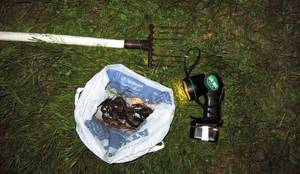
To effectively catch crayfish you will need the following:
- Flashlight. It is advisable that it have a water-resistant case, as there is a high probability of dropping it into water. You will also need a securing cord to secure it to your hand in case the flashlight falls.
- Net or gloves. They are necessary to protect hands from possible damage from claws. The first requires practice, since when there is danger, the crayfish can develop high speed - in one swing of the tail it moves 20 cm.
- Boots or other waterproof footwear. Water temperatures may be low during the fishing season. To prevent chills or illness, foot protection is recommended.
Cloudy weather increases the chances of large numbers of prey. But it can also cause poor visibility. Read about how atmospheric pressure affects fishing here.
Nets for catching crayfish, or nets
Rachevni are made cylindrical from mesh, which are put on a metal ring. Rings are now made from wire. The ring is approximately 50 cm in diameter; several ropes of the same length need to be attached to it so that our rachevna does not warp. They are connected to each other and a cord is tied to them to lower and raise the trap.
The bait must be tied to a net or to a cord stretched across the diameter of a hoop, and the trap is lowered to the bottom. The rope from the ranch needs to be tied on the shore or to a stick stuck in the bottom not far from the shore. When fishing for crayfish, the crayfish that grab the bait cannot escape from it themselves. When lifting the farmhouse, you should not hesitate. It is immediately advisable to place several such traps at a distance of no more than 10 meters from each other.
A trap with two hoops is more effective; in it, the hoops are located at a distance of 10 cm from each other. At the bottom, these hoops are folded, and when taken out, they stretch and do not allow the crayfish to leave the trap. You can also use large nets. At the bottom of such a trap there is either a stick or a rod to which a handle is attached. A mesh in a metal casing is attached to them. Such a net must be moved along the bottom, which should be relatively flat so as not to damage the net.
How to catch crayfish with meshes
Crayfish traps are traps for catching crayfish that appeared in the 19th century; they have an advantage over other traps that we discussed above. Their main advantage is that they do not need constant checking, because once the crayfish get there they cannot get out on their own. This makes it possible to install several measures at once and not have to constantly monitor them.
The downside to net fishing is that it is less exciting than diving for crayfish or using pincers. lovers There are several types of hems. Meshes for crayfish are a simple version of meshes for catching fish. According to the design of the neck, there are two types of hems: – standing hems , with an upper neck location; – lying hems , with side necks;
Let's consider standing hems
What standing edges have in common is one neck and the shape of a cone, pyramid or hemisphere. The meringues must be lowered to the bottom vertically so that the neck is on top. The bottom of the hemstone should be round or triangular. Nowadays, hemispherical hemlocks with a round bottom are mainly used. The frame for the standing hem is made of wire that connects the neck and the lower hoop.
Previously, the frame body was made of wooden rods, but now it is made entirely of wire. Inside the neck you need to tie a round collar with a diameter of no more than 10 cm. It must be slippery so that the crayfish falls along it and cannot get back out. If you make the neck removable, the crayfish will be easily removed from it.
The diameter of the collar should be made slightly smaller than the neck itself. The mereja is turned over and the crayfish pour out of it freely. It is better to make the merezhi collapsible, then it is better to transport them in large quantities. Nowadays, nets made of nylon threads are used; they are durable and fold well. They cannot be boiled; it is enough to rinse them after each crayfish hunt.
The mesh size should be set as for live bait, no more than 20 mm. The bait must be tied with a fishing line to the net so that it is in the middle or at the bottom of the mesh. Or come up with another method of attachment, but the main thing is that the bait is not on the edge of the net, since the crayfish should feast on it inside the trap, and not outside. And the cancer couldn’t pull it out and leave you without a catch.
Let's consider recumbent hems
Recumbent meshes for catching crayfish are elongated in length and have one or two necks. They need to be lowered to the bottom horizontally, so that the necks are parallel to the bottom. They have a triangular, rectangular, cylindrical shape.
Cylindrical hems - made entirely of mesh. The necks are made with a diameter of approximately 10 cm and are located on the sides. The necks are tied together with ropes so that they are taut and the crayfish can crawl into them freely, and at the same time, the laces prevent the crayfish from escaping from the trap. The length of the trap is no more than 50 cm, with a diameter of 20 cm.
Wooden (twig) frames are less frightening to crayfish than wire and mesh frames. Crayfish enter them freely without feeling any danger. But folding hems take precedence because of their mobility. They are made of wire in the form of a spiral or rings. They straighten out and lie on the bottom in an extended state, securing the rings along the edges with a stretch.
The spring mesh opens simply, you just need to release the stopper and it will stretch out. Triangular hems are made from triangles connected to each other by a mesh. The dimensions are the same: length 50 cm, width 20 cm. They also have necks - along the edges of the hem (from the ends). They lower it into the water on one of the faces. The downside to such bags is that they don’t fold up and you can’t take a lot of them with you.
Semi-cylindrical hems are made from several so-called semi-hoops. Which are connected to each other by slats. Everything is covered with mesh on top. Such hemlines have one or two necks. The dimensions are the same: length 50 cm, width 20 cm. In recumbent mesh, the bait should be attached like this. so that it hangs in the middle or is tied in the middle to the bottom of the trap. It is difficult for crayfish to get out of such traps, but when they fall into a trap, they begin to look for a way out.
Therefore, you need to check the traps periodically, three times a night, and collect prey. Which mesh is better to fish with? It all depends on the place of fishing, the bottom of the reservoir. And the quality of the hems made. Of course, wooden ones are less frightening to crayfish, but wire ones are more reliable. It's better if there are two necks. Collars should be slippery. And if you put a lot of lines, then it is advisable to connect them with one rope for ease of searching and checking crayfish.
Catching crayfish with a merezh
The most common model of hedging is domed with a round bottom. Such a hem has a rod for tying bait and a “collar” made of plastic, birch bark or tin. The diameter of the hoop at the bottom of the hem is approximately 40 cm, the diameter of the neck is 15 cm, and the height is 15-30 cm.
The frame for a standing hem, essentially one of the types of crayfish, is made as follows. The lower hoop is connected to the neck hoop with pieces of wire in 4-6 places. In the dome frame, the rods that connect the hoops are curved inward. Other forms of hemlines have straight or slightly curved rods. A round, necessarily slippery (so that the caught crayfish cannot escape), “collar” with a diameter of 10 cm, which can be made of tin, plastic or birch bark, is glued to the inside of the neck. Many crayfishers make the neck removable: after removing it, the crayfish pour out of the mesh with ease. The upper part of the neck can be made of mesh, and the “collar” can be moved to the lower tackle.
| Advice. Make the diameter of the hem collar slightly smaller than the diameter of the neck. |
To extract crayfish from the mesh, it is turned upside down, and its “collar” comes out, resulting in the formation of a funnel through which the caught crayfish fall.
Folding hems
Folding hems are very convenient. They are easy to store and transport to the place where you will catch crayfish. They are installed vertically, with the neck attached to the upper bow. Folding hems do not have supporting frame rods. The neck of the hem is made of mesh, and a wire ring is attached to the bottom edge. When the hemline is lifted from the reservoir, the ring is pulled out and the neck straightens. For folding hems, you can use removable “collars”.
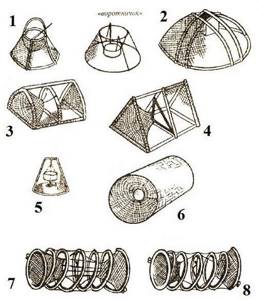
Figure 5. Merezhi
1 - conical; 2 - dome; 3 - semi-cylindrical; 4 - triangular; 5 - folding; 6 - wooden; 7 - easy to install; 8 - improved model.
In order to attach the bait to the standing fences, a twig with bait attached is passed across the fence. The twig is attached to the mesh with a split end. Hang the bait on a hook or on a piece of fishing line right in the middle of the line. The bait either hangs, tied to a fishing line (the fishing line is stretched across the neck), or lies fixed at the bottom of the net.
| On a note. But it is best if the bait hangs, because the crayfish, being in the trap, should not completely destroy the bait. In this case, the bait must be attached in such a way that the crayfish cannot pull it out entirely. |
A twig with bait can also be attached to the neck in its lower part.
The crayfish are taken out of the mesh through the neck, and the mesh is turned upside down. You can also get crayfish through a special opening valve.
Recumbent hems are lowered to the bottom in a horizontal position. Such hemlines have 1 or 2 necks and an oblong shape. The neck of the mesh is located parallel to the bottom of the reservoir. Recumbent hems can be cylindrical, semi-cylindrical and triangular.
Cylindrical hems
Cylindrical hems are used mainly in reservoirs with crayfish, where the bottom is rocky and uneven. They are placed vertically. Such hemlines are made from rods. New models of cylindrical hems are made of mesh. At the ends of the hemline there are necks, the diameter of which is about 10 cm. In order for the hemline to be straightened, its necks are connected to each other with 3-4 laces. The laces usually run straight or crosswise through the hem. The laces also create an additional obstacle for those crayfish that, having already been caught, are trying to get out. The length of the hem is half a meter, diameter is 20 cm.
The neck of the cylindrical hem is a narrow slit. The gap is formed by the laces that are attached to the hoops (the laces are tightened). Crayfish easily fall into the trap, and the crayfish can no longer get out of it through the narrow mesh gap.
| On a note. The most catchy ones are considered to be those made from wooden planks and rods, i.e. wooden. The effectiveness of such barriers is determined by the fact that they are darkened: crayfish even during the day seek shelter. |
Triangular hems
The disadvantage of a triangular hem is that it does not fold. But thanks to the wide and straight edges, such hems are stacked during transportation and storage. The frame for such a hem is triangles and supports. Triangles are made of metal rods or wooden slats. The supports connect the sides of the triangles and accordingly there should be three of them. The frame is covered with mesh. The necks of the hemstitch are located in the middle of the triangles. The height of the hem is 20 cm, the length is half a meter.
Semi-cylindrical mesh
The frame of the semi-cylindrical hem is made of 3 semi-circular wooden hoops. These hoops are connected to each other by bars. The frame is covered with mesh. This hemline may have 1 or 2 necks. The length of the hem is half a meter, height is 25 cm.
To secure the bait in the lying mesh, it is strung on a rod. A twig (or cord) is attached in the middle of the hem and always across it. The crayfish bait can also be hung on a wire hook. The hook, in turn, is attached to the supporting hoop.
The mesh for standing and lying hems must be durable and strong. In addition, it must withstand boiling. The mesh is made of artificial fiber, cotton or linen threads.
Indicators of the most catchable mesh model:
- The frame consists of rods and wooden sticks (or the hem is made of cotton or flax fiber).
- The neck is in the form of a narrow slit.
- Slippery collar.
- Recumbent hems should have two necks.
- The bait is tied tightly.
- The mesh cells should be 18-20 mm.
If several measures are used, then they are placed 5 meters from each other. In a large fishing area, the lines are connected to each other with one long cord. To prevent the cord from catching on uneven bottoms, buoys are tied to the cord between the hems.
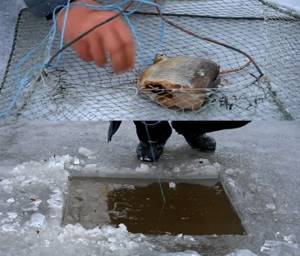
Photo of catching crayfish in winter with a crayfish trap
| Read the article about crayfish farming |
How and where should you catch crayfish?
Crayfish catches depend on certain conditions. The main condition is water. If it is dark, light does not pass through it well. In it, crayfish begin to hunt earlier and traps can be set during the day, the activity of crayfish will remain until late in the evening, and at night it decreases. If the water in the reservoir is light water, traps need to be set later. with the onset of darkness. Crayfish activity continues throughout the night.
By morning the activity decreases, but you can still catch crayfish. In dark water, traps are placed at a shallower depth than in light water. I would dive and catch crayfish with my hands even during the day and before dark. Another condition is the weather. If the weather is cloudy, then you can start catching crayfish earlier. On a clear day, you need to wait until the sun begins to set. Cancer is less active during the full moon and when it is cool, also during thunderstorms.
Traps can be placed at different depths, from 1 meter to several meters. You need to collect crayfish in an iron bowl; they won’t bite through it and won’t run away. While diving, I collected crayfish in an iron cage. A float made from a plastic bottle was tied to it on a long rope. This helped to always know where the cage was under water.
We looked at how to catch crayfish. What mesh and bait to use. I hope this helps you at least a little. Good luck catching crayfish!
To Home Page.
Which bait is best for catching crayfish?
The best bait for catching crayfish using crayfish and other devices is fish, frogs and minnows. Sometimes snails serve as bait. The best bait is bream, roach, silver bream and other carp fish. The bait is cut along the back to the vertebrae, the meat is turned out. This is necessary so that the fish, located as bait where the crayfish are, emits a strong odor that attracts the crayfish. In addition, the bait must be fresh and elastic. Burbot, pike and perch are completely unsuitable as bait.
